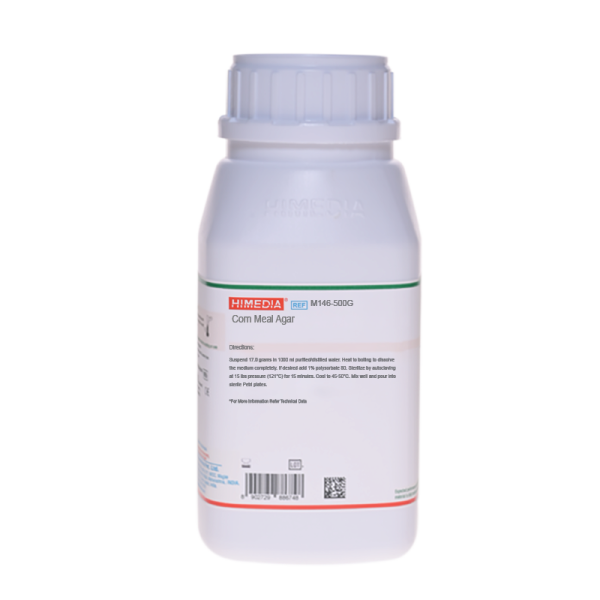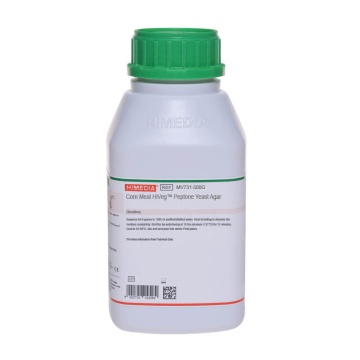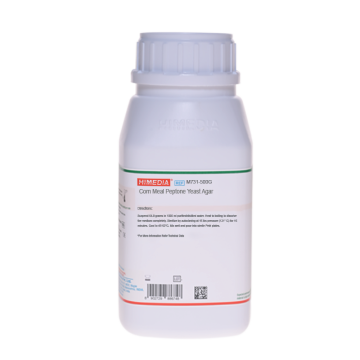 Your enquiry has been submitted
Your enquiry has been submitted
Corn Meal Agar
Intended use
Recommended for chlamydospore production by Candida albicans and the maintenance of fungal stock cultures.
Composition**
| Ingredients | Gms / Litre |
|---|---|
| Corn meal, infusion from | 50.000 |
| Agar | 15.000 |
Final pH ( at 25°C): 6.0±0.2
**Formula adjusted, standardized to suit performance parameters
Directions
Suspend 17 grams in 1000 ml purified/ distilled water. Heat to boiling to dissolve the medium completely. If desired add 1% polysorbate 80. Sterilize by autoclaving at 15 lbs pressure (121°C) for 15 minutes. Cool to 45-50°C. Mix well and pour into sterile Petri plates.
Principle And Interpretation
Chlamydospore production is an accepted criterion for the identification of Candida species. Corn Meal Agar is a well-established mycological medium used for the cultivation of fungi and to study chlamydospores production of Candida species (6). Corn Meal Agar is a general purpose medium used for the cultivation of fungi and for the study of Candida species for chlamydospore production. Pollack and Benham (6) have described the usefulness of this medium for studying the morphology of Candida. Walker and Huppert (8) modified this medium by adding polysorbate 80, which then stimulated faster and plenty of chlamydospore formation of Candida species.
This is a very simple formulation containing only cornmeal infusion and agar. However this infusion has enough nutrients to enhance the growth of fungi. Polysorbate 80 is a mixture of oleic esters, which activates the production of chlamydospore by Candida albicans, Candida stellatoides and Candida tropicalis (3). Some Candida species lose their ability of chlamydospore formation by repeated sub culturing.
Pick a suspected colony from Sabouraud Dextrose Agar (M063) using a straight wire, and make a deep cut in the Corn Meal Agar plate. Repeat for each colony. Place a flamed sterile coverslip over the line of inoculum. After incubation for 24-48 hours at 25-30°C, the streaks are examined microscopically, through the coverslip, using low and high power objectives. C.albicans produces mycelium bearing ball-like clusters of budding cells and characteristics thick walled round chlamydospores (2).
Type of specimen
Food and dairy samples.
Specimen Collection and Handling
For food and dairy samples, follow appropriate techniques for sample collection and processing as per guidelines (7,8). After use, contaminated materials must be sterilized by autoclaving before discarding.
Warning and Precautions
Read the label before opening the container. Wear protective gloves/protective clothing/eye protection/ face protection. Follow good microbiological lab practices while handling specimens and culture. Standard precautions as per established guidelines should be followed while handling specimens. Safety guidelines may be referred in individual safety data sheets.
Limitations
- Further biochemical tests must be carried out for confirmation.
Performance and Evaluation
Performance of the medium is expected when used as per the direction on the label within the expiry period when stored at recommended temperature.
Quality Control
Appearance: Cream to yellow coarse free flowing powder
Gelling: Firm, comparable with 1.5% Agar gel
Colour and Clarity of prepared medium: Light amber coloured, opalescent gel forms in Petri plates
Reaction: Reaction of 1.7% w/v aqueous solution at 25°C. pH : 6.0±0.2
pH: 5.80-6.20
Cultural Response
Cultural characteristics observed after an incubation at 23-27°C for upto 4 days.
| Organism | Inoculum (CFU) | Growth | Chlamydospores | Recovery |
|---|---|---|---|---|
| Aspergillus brasiliensis ATCC 16404 (00057*) | 50-100 | luxuriant | negative | |
| Candida albicans ATCC 10231 (00054*) | 50-100 | luxuriant | positive | >=70% |
| Saccharomyces cerevisiae ATCC 9763 (00058*) | 50-100 | luxuriant | negative | >=70% |
| Saccharomyces uvarum ATCC 28098 | 50-100 | luxuriant | negative | >=70% |
Storage and Shelf Life
Store between 10-30°C in a tightly closed container and the prepared medium at 20-30°C. Use before expiry date on the label. On opening, product should be properly stored dry, after tightly capping the bottle in order to prevent lump formation due to the hygroscopic nature of the product. Improper storage of the product may lead to lump formation. Store in dry ventilated area protected from extremes of temperature and sources of ignition Seal the container tightly after use. Use before expiry date on the label.
Product performance is best if used within stated expiry period.
Disposal
User must ensure safe disposal by autoclaving and/or incineration of used or unusable preparations of this product. Follow established laboratory procedures in disposing of infectious materials and material that comes into contact with clinical sample must be decontaminated and disposed of in accordance with current laboratory techniques (2,4).
Reference
- American Public Health Association, Standard Methods for the Examination of Dairy Products, 1978, 14th Ed., Washington D.C.
- Conant N. F., Smith D. T., Baker R. D., Callaway J. L. and Martin D. S., 1971, Manual of Clinical Mycology, 3rd Ed., USA
- Cooper and Silvo-Hunter, 1985, Manual of Clinical Microbiology, Lennette, Balows, Hausler and Shadomy (Eds.), 4th ed., ASM, Washington, D.C.
- Isenberg, H.D. Clinical Microbiology Procedures Handbook. 2nd Edition.
- Jorgensen, J.H., Pfaller, M.A., Carroll, K.C., Funke, G., Landry, M.L., Richter, S.S and Warnock., D.W. (2015) Manual of Clinical Microbiology, 11th Edition. Vol. 1.
- Pollack and Benham, 1960, J. Lab. Clin. Med., 50:313.
- Salfinger Y., and Tortorello M.L. Fifth (Ed.), 2015, Compendium of Methods for the Microbiological Examination of Foods, 5th Ed., American Public Health Association, Washington, D.C.
- Walker and Huppert, 1960, Tech. Bull. Reg. Med. Technol., 30:10.
| Product Name | Corn Meal Agar |
|---|---|
| SKU | M146 |
| Product Type | Regular |
| Physical Form | Powder |
| Origin | Animal Free (Veg) |
| Packaging type | HDPE |
| References | 1. Pollack and Benham, 1960, J. Lab. Clin. Med., 50:313. 2.Walker and Huppert, 1960, Tech. Bull. Reg. Med. Technol., 30:10. 3.Cooper and Silvo-Hunter, 1985, Manual of Clinical Microbiology, Lennette, Balows, Hausler and Shadomy (Eds.), 4th ed.,ASM, Washington, D.C. 4.Conant N. F., Smith D. T., Baker R. D., Callaway J. L. and Martin D. S., 1971, Manual of Clinical Mycology, 3rd Ed., USA5.Isenberg, H.D. Clinical Microbiology Procedures Handbook. 2nd Edition. 6.Jorgensen,J.H., Pfaller , M.A., Carroll, K.C., Funke, G., Landry, M.L., Richter, S.S and Warnock., D.W. (2015)Manual of Clinical Microbiology, 11th Edition. Vol. 1. 7.American Public Health Association, Standard Methods for the Examination of Dairy Products, 1978, 14th Ed., WashingtonD.C. 8.Salfinger Y., and Tortorello M.L. Fifth (Ed.), 2015, Compendium of Methods for the Microbiological Examination ofFoods, 5th Ed., American Public Health Association, Washington, D.C. |
| Customized Product Available | No |








